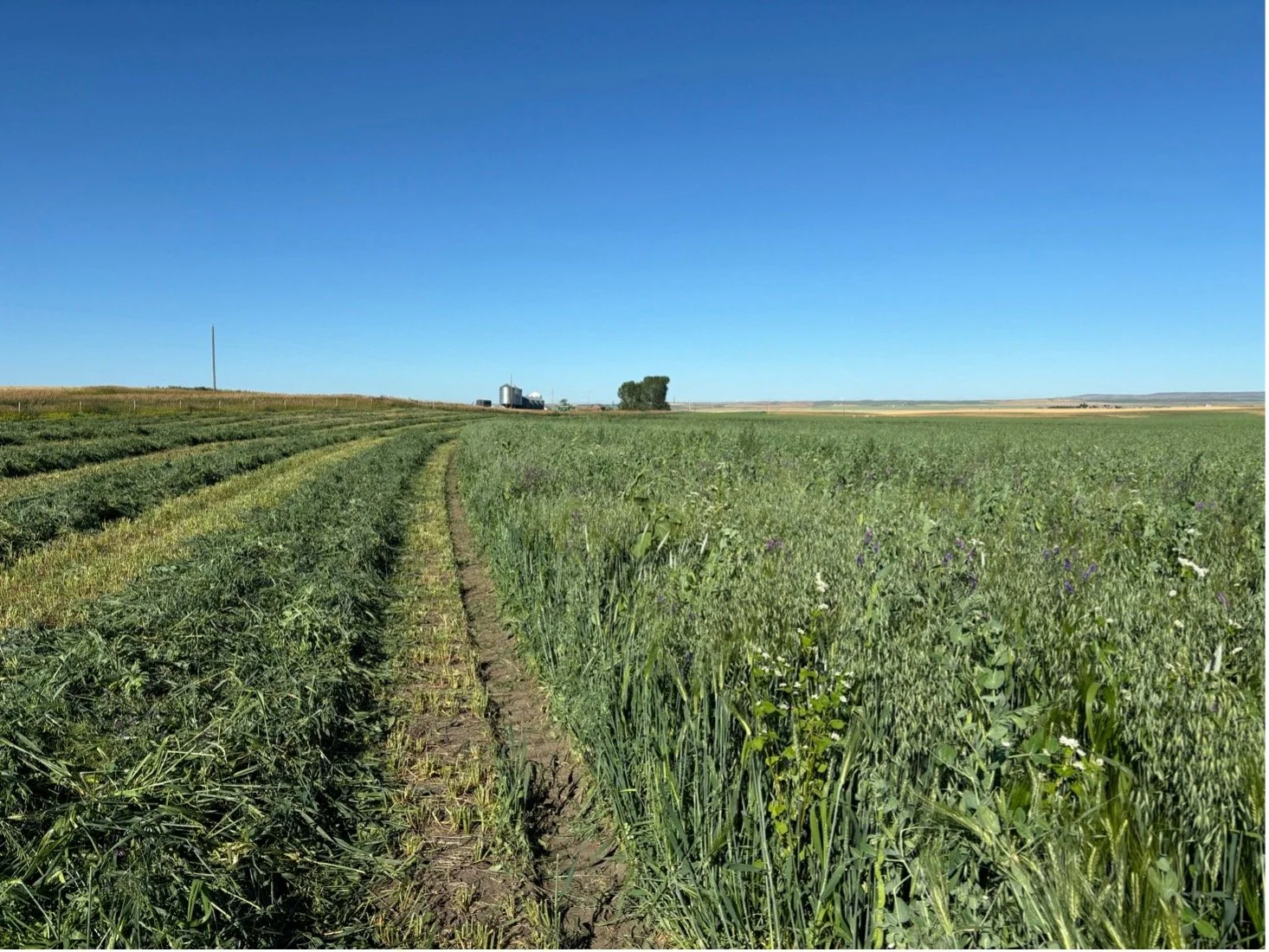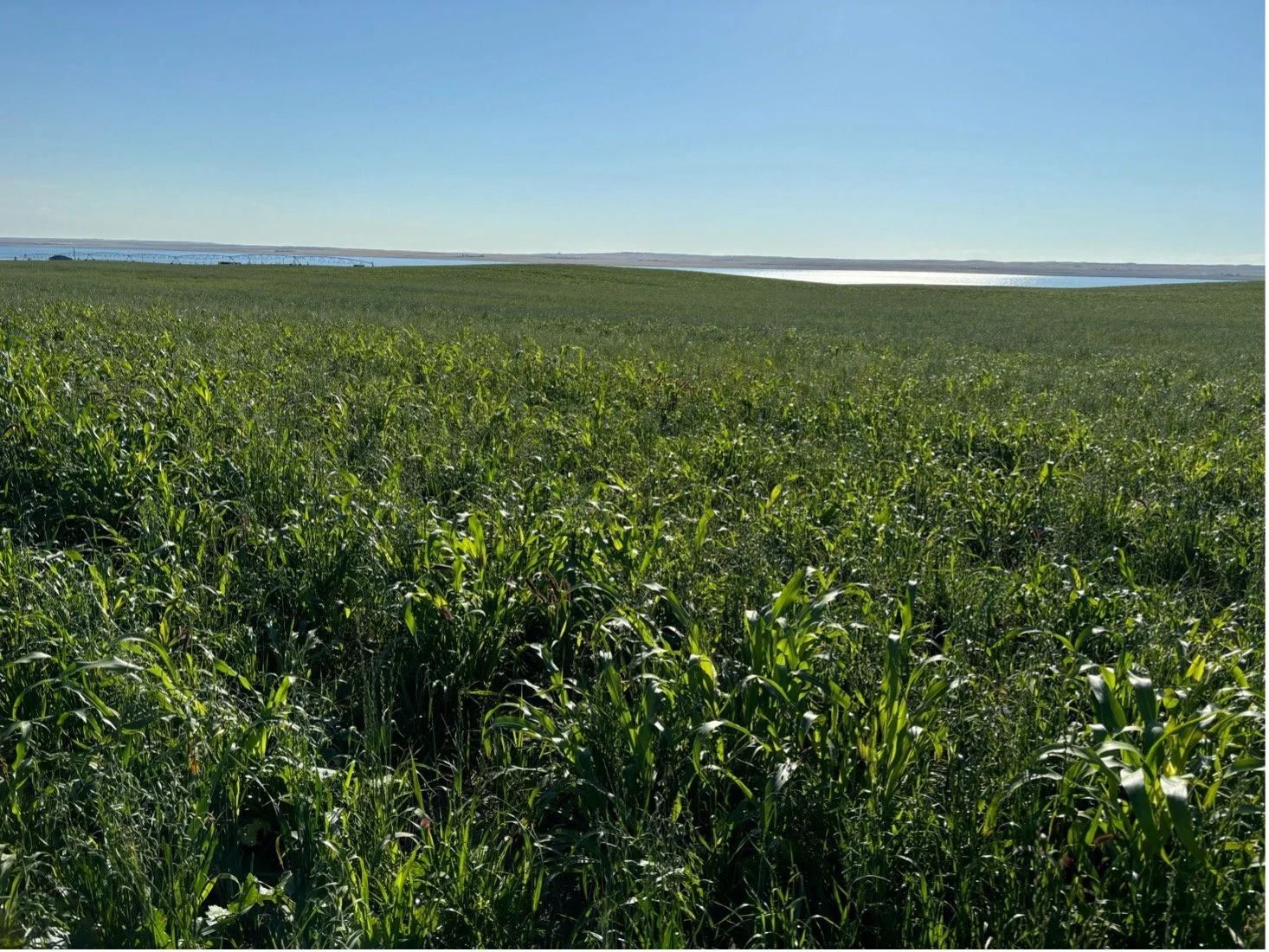Seed Once, Harvest Twice: Full Season Cover under Irrigation
Farm Research Partner: Kevin Booth
Growing Season: 2024
Location: 1 mile SE of Milo, Alberta
Soil Zone: Dark Brown Soil Zone
Accumulated Rainfall (Including Irrigation): 633 mm
Researcher & Author: Dakota Odgers
On-Farm Research
Seeding & Germination
Kevin Booth resides in the Dark Brown Soil zone and farms with his family in Milo, Alberta, one-mile southeast of the town. The Booth family's study field spans 147 acres, with 135 acres having access to irrigation during the growing season. The trial field received a glyphosate application as a spring burn-off and was seeded to a Full Season Cover crop on May 27, 2024. The trial field was also fertilized with 35 lbs. of actual nitrogen at seeding. No other synthetic inputs were applied to the field during the remainder of the trial.
Pre-burn Application: Roundup in spring
Fertilizer: 35 Ibs of actual Nitrogen fertilizer applied
Seeding Date: May 27th, 2024
Trial Details: Evaluate the cost of production, regrowth & overall economic analysis of a Full Season Cover under irrigation.
Figure 2. Picture taken of Full-Season cut on August 6th, 2024
On-Farm Research
The Growing Season
Accumulated Rainfall (mm)
After a very dry 2023 in which the Booth family was left with limited irrigation access, they looked to utilize the irrigation before seeding to help build soil moisture reserves. After 2023, the Booth family entered the 2024 growing season, intending to use water as efficiently as possible. The access to irrigation served as an external source to the Booth’s operation to help improve the soil moisture profile while planting a Full Season Cover aided through diverse plant selection to help improve proper water infiltration and water retention.
The Booths planted their Full Season Cover on May 27th, using their irrigation pivot after seeding to support germination. During the growing season, the Booth family looked to apply 18-20mm of water through irrigation when making a pass with the pivot. The growing season brought mixed rainfall patterns. From June 15th to 18th, they received 30mm of rain, followed by 33mm on June 27th and 28th. However, July was extremely dry, with only 5mm of rainfall for the entire month. July was the month that the Booths relied heaviest upon irrigation to compensate, targeting 20-25 mm per week, with total rainfall of only 5mm for the entire month. Moisture returned in August with two significant rain events, bringing 112mm for the month—nearly 50mm from August 3rd to 5th and 42mm on August 28th.
Moving into September, it was a mixture of natural rainfall and irrigation to maximize regrowth through plant diversity. The key for the Booth family was to ensure they could utilize plant diversity to its fullest potential throughout the growing season for both a silage cut and to enhance regrowth, enabling the swath grazing method of feeding into their winter feeding program. By incorporating swath grazing into their winter feeding plan, the Booth family did not begin feeding mechanically until March 2025, maximizing plant diversity by capturing sunlight and water throughout the growing season through silage, regrowth, and identifying low-cost winter feeding options.
Table. 1 (graph) Rainfall totals from the growing season. Rainfall totals for entire growing season were verified with Kevin Booth pivot usage over growing season but single pass data was not present for the purpose of the study.
On Farm Research
Harvest
With access to irrigation, Kevin Booth and his family planned from the start of the growing season to maximize the use of the Full-Season cover crop. With water as a non-limiting factor, they produced silage from the first cut of the Full-Season while using the irrigation for regrowth to harvest through swath grazing.
On August 6th, 2024, the Full-Season cover crop was harvested, marking 71 days between seeding and harvest. As shown in Figure 3, the cover crop was taken while still in a vegetative state. This benefited the Booths’ operation in several ways, leading to extremely high feed quality while allowing the plants, which received irrigation and natural rainfall, to regrow rapidly. The feed values of the first cut silage are illustrated in Test 1, where a total of 8 tons per acre was averaged across the first cut of the Full-Season, with a moisture content of 63%, a crude protein level of 14.6%, and TDN of 55.5%. Once the crop was removed from the field, the Booths initiated their irrigation program in conjunction with the natural rainfall presented in Table 1.
After leaving the crop to regrow and applying irrigation, the Booth family swathed the regrowth of the Full-Season cover crop on September 28th, marking 53 days between the first and second cuts. Following harvest through the swath grazing method, the field remained available for any natural regrowth until the cattle were placed in the area on December 27th, marking 90 days from the swath grazing cut to the cattle being placed on the Full-Season swaths.
Kevin Booth reported that when the cattle were introduced, they consumed the swaths and foraged between the rows where the crop continued to grow into the fall months. Additionally, the swaths were feed tested, as illustrated in Test 2, showing a crude protein level of 13.7% and TDN of 55.2%.
First cut of Full-Season on August 6th, 2024
Feed Analysis (1st cut): First cut for Silage of Full-Season August 6, 2024
Second cut for Swath Grazing on September 28, 2024.
Feed Analysis (2nd cut): Second cut for Swath Grazing cut on September 28, 2024
On-Farm Research
Regrowth
Figure 5. Cows Swath Grazing Full-Season regrowth January 5, 2025
Upon harvesting the Full-Season on August 6th, the Booths left the crop to regrow for 53 days before the second cut for swath grazing on September 28th. Cattle were placed on the field for swath grazing on December 27th. The method of swath grazing allowed the Booths to capture not only the biomass in the swaths but also the regrowth occurring between them. The Booths first introduced cattle to the trial field on December 27th, consisting of 56 heifers with an AU of 1.1 and 216 cows with an AU of 1.35.
Additionally, on January 4th, 44 cows, also with an AU of 1.35, were added to the group, bringing the total from January 4th to January 31st to 260 cows with an AU of 1.35 and 56 heifers with an AU of 1.1. Kevin Booth maintained the paddock size at approximately 20 acres per paddock. While the animals were in the trial area, they did not receive any supplemental feed, as the feed tests and consultations with their nutrition program provided them the flexibility to do so.
In total, the animals were fed on the trial area of 147 acres for 35 days without supplementation. All animals were removed from the trial field on January 31st, completing all information for the purpose of the study for the growing season.
Figure 1. Picture of Full-Season regrowth taken on September 16th, 2024
Farm Research
Cost Of Production Analysis
Table 3. The cost for seed is based on the March 15th pre-buy deadline with inoculant. The cost of the sprayer, labour, and swather is based on the Saskatchewan Farm Machinery Custom and Rental Rate Guide https://publications.saskatchewan.ca/#/products/76527. Seeding Cost, Silage Cost and Silage Tarp, Irrigation Service/Water Charge and Fertilizer are based on actual cost.
Land Cost, Irrigation Power, and Irrigation System are based on cost breakdown from https://irrigationsaskatchewan.com/icdc/publications/c-irrigation-economics-agronomics/
Seed & Inoculant: $79.00/acre
Fertilizer: $35.00/acre
Herbicide & Sprayer Cost: $20.00/acre
Seeding Cost: $30.00/acre
Labour: $11.80/acre
Land Cost: $175.00/acre
Fencing Materials: $6.80/acre
Irrigation Power (135 acres): $24.75/acre
Irrigation Repair (135 acres): $16.92/acre
Irrigation Service, Water (135 acres): $18.37/acre
Irrigation System: $40.01/acre
Swather: $18.00/acre
Silage Cost (Swathing, Trucking, Packing): $123.52/acre
Silage Tarp: $12.48/acre
TOTAL COST: $611.65/ACRE
On-Farm Research
Total value/Irrigated Acre
Feed Value (8 Tons of Silage): $528.00 (calculations below)
Feed Replacement Cost ($0.075/lb feed) as compared to regrowth grazing: $213.77
Total Output of Field with Feed and Grazing: $741.77/acre
Total Cost: $611.65/acre
TOTAL PROFIT: $130.12/ACRE
*Feed Value calculated using https://www.thecattlesite.com/news/31705/pricing-silage
Group 1: 56 Heifers X 1100.00 LBS=61600 LBS= + 216 Cows X 1350.00 LBS=291600 LBS=61600LBS + 291600LBS=353200 Total LBS on Field/1000=353.20 X35 days=12362/147acres=84.1 AU/Acre
Group 2: 44 Cows X 1350.00lbs=59400 total LBS of field/1000=59.40 X27 days=1603.80/147acres=10.91 AU/Acre
AU Calculation= 84.1 AU/Acre + 10.91 AU/Acre= 95.01 AU/Acre total
Feed Replacement Cost=95.01 AU X 30lbs dry matter replacement= 2850.30lbs daily intake X ($.075lbs) =$213.77 added value per acre X 147 acres=$31424.55 total feed savings
On-Farm Research
Conclusion
Through plant diversity, Kevin Booth achieved two crops from one planting. With the first cut of silage and access to irrigation, Kevin did not need to replant and add extra cost to his operation. Instead, he maximized the 96% of what a plant is made of: sunlight and water. This provided Kevin with two low-cost winter feed options to help set him up for future success this winter and the soil health benefits to this field through future years with animal integration and nutrients being returned to the field.
One aspect to consider in future iterations of this study is water usage early in the growing season. In this context, the question is posed as follows: Given the high composition of cool season plants in the iteration of the Kevin Booth study, is it better for a producer to allow warm season plants higher potential to capture sunlight during the initial stages of canopy development, thereby maximizing their sunlight-capturing potential? Once this occurs, water would be utilized at higher rates so that warm and cool season plants have an equal opportunity for sunlight. This question will be researched in the upcoming growing season of 2025.




